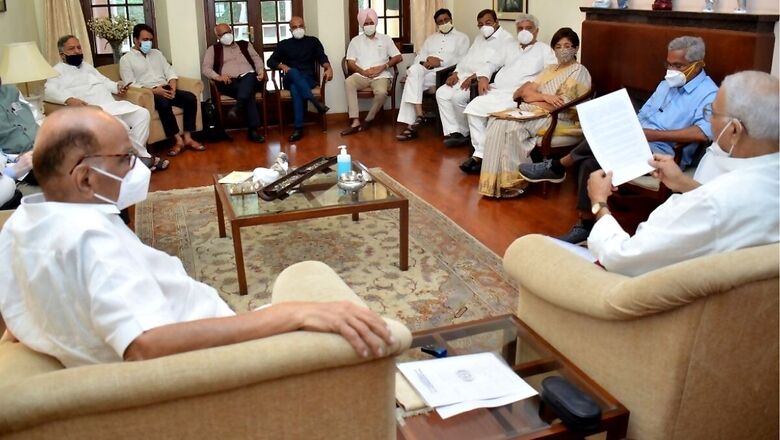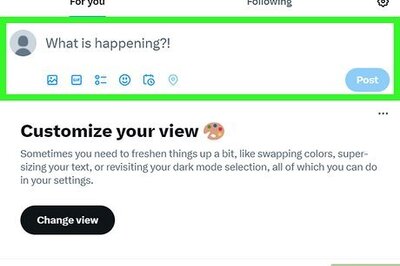
views
On June 22, when representatives of opposition parties met at the residence of Sharad Pawar under the banner of the Rashtra Manch, a three-year-old outfit set up by Yashwant Sinha, the Uttar Pradesh elections came up for discussion. The subject was not listed on the agenda but halfway down the sitting, the discussions, that centred on the “issues of the day”, got less structured. Someone asked if the UP polls had the potential to create a national alternative but the question remained unanswered because nobody proffered a response. Early days, it was said.
At this meeting, UP was represented by Jayant Chaudhary, the Rashtriya Lok Dal (RLD) leader, who was anointed the party president this year after the death of his father, Chaudhary Ajit Singh. Ghanshyam Tiwari, a Samajwadi Party (SP) spokesperson, was also present. In any case, Jayant and Tiwari have been associated with Sinha’s outfit for some time. Jayant’s presence was significant because the RLD is the BJP’s principal challenger in the Jat-dominated parts of west UP. The RLD has cemented an alliance with the SP but there’s little else by way of an opposition coalition before UP votes in February-March 2022.
So, can the elections serve as a precursor to bringing the non-BJP spectrum together and lay the ground for opposition unity before the 2024 general elections? The prospect presently appears distant. Apart from the SP and the RLD, UP has two other major players: the Bahujan Samaj Party (BSP) and the Congress. While the BSP chief, Mayawati, ruled out the possibility of a tie-up with any entity once speculation gained momentum that she was about to do business with Asaduddin Owaisi’s AIMIM, the Congress similarly seems averse to acquiring partners.
The Congress’s alliance with the SP in the 2017 assembly polls that birthed mega posters of Rahul Gandhi and Akhilesh Yadav together with the slogan, “UP ke do ladke (UP’s two boys)”, was a washout. The idea of juxtaposing Rahul and Akhilesh was to reach out to the state’s burgeoning young voters and carve out a new demographic constituency. By then, UP’s youths were sold on Prime Minister Narendra Modi and the BJP. Recent history demonstrated that non-BJP alliances do not work the way they did in 1993, when Akhilesh’s father and the SP founder, Mulayam Singh Yadav, reached out to the BSP, then helmed by its architect, Kanshi Ram, accepted the terms and conditions laid down by Ram in an extraordinarily hard bargain, fought that year’s assembly polls together, and beat the BJP by a whisker against all expectations.
In 2019, the SP, BSP and RLD came together to combat a BJP which was on a high since 2014. The trio was routed in the assembly elections that upended cast-in-stone caste equations and conjoined disparate castes and sub-castes under the rubric of a larger Hindu identity. The SP-BSP-RLD arrangement was tenuous and didn’t work on the ground because of traditional antagonisms between a dominant backward caste like the Yadavs and the Dalits or the Jats and Dalits over landholdings and control of economic resources were too deeply embedded to be papered over by a political alliance. The respective party workers were aloof from one another.
However, the SP and the RLD sustained the pact in whatever ways they could, so the leaders believe that they can seek out their voters from a position of greater “stability and credibility” than what they held in 2019. Akhilesh and Jayant are working towards drawing up a scenario with three elements: within the alliance, create space for a host of smaller but influential identity-based parties, give a “national” colour and impact to the campaign by bringing in leaders such as Mamata Banerjee and Tejashwi Yadav, and lastly work towards making the contest a bipolar fight against the BJP. While Jayant is in the throes of establishing his writ over the RLD and probably recasting its organisation, the SP has mobilised its workers through virtual sessions during the pandemic and involved them in providing healthcare and relief.
The SP and the RLD have not hit the ground for two reasons. The pandemic and the apprehension that an early display of aggression could provoke a backlash from the Yogi Adityanath government, resulting in repression and long arrests that could demoralise the cadre before the elections. They have demonstrated their dissent and criticisms of the government on social media.
This is not to say that the BSP and the Congress will mean nothing, particularly the BSP that has a pocket of captive votes, even in adversity. The Congress’s UP engagement is patchy as the Gandhi siblings arrive now and then, cause a buzz, and then disappear. Moreover, the UP Congress president, Ajay Kumar Lallu, has a proven record of staging street fights and courting arrest but has not been accepted by the party’s veterans, each of who has a following in different measures.
Mayawati has maintained a low profile that is uncharitably ascribed to the charges of financial malfeasance against her and her family. She has not confronted the Adityanath regime even mildly. Her tactics serve the BJP well because, in the past, Mayawati was always counted upon by the BJP to bail it out in case the elections threw up an uncertain verdict.
UP is certain to see a multi-cornered contest that always helps the BJP. Right now, the prospective permutations and combinations do not add up to painting a picture of national unity that sections of the opposition envisage.
Read all the Latest News, Breaking News and Coronavirus News here.

















Comments
0 comment